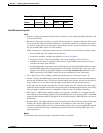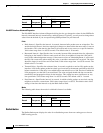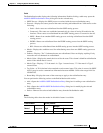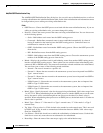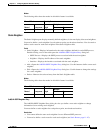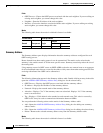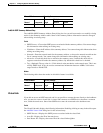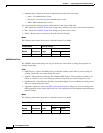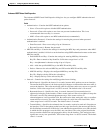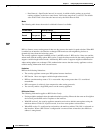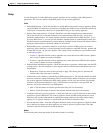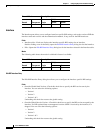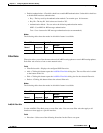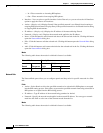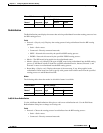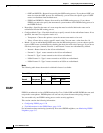
11-21
Cisco ASDM User Guide
OL-16647-01
Chapter 11 Configuring Dynamic And Static Routing
Dynamic Routing
Advanced OSPF Virtual Link Properties
The Advanced OSPF Virtual Link Properties dialog box lets you configure OSPF authentication and
packet intervals.
Fields
• Authentication—Contains the OSPF authentication options.
–
None—Choose this option to disable OSPF authentication.
–
Password—Choose this option to use clear text password authentication. This is not
recommended where security is a concern.
–
MD5—Choose this option to use MD5 authentication (recommended).
• Authentication Password—Contains the settings for entering the password when password
authentication is enabled.
–
Enter Password—Enter a text string of up to 8 characters.
–
Re-enter Password—Reenter the password.
• MD5 IDs and Keys—Contains the settings for entering the MD5 keys and parameters when MD5
authentication is enabled. All devices on the interface using OSPF authentication must use the same
MD5 key and ID.
–
Enter MD5 ID and Key—Contains the settings for entering MD5 key information.
Key ID—Enter a numerical key identifier. Valid values range from 1 to 255.
Key—An alphanumeric character string of up to 16 bytes.
–
Add—Adds the specified MD5 key to the MD5 ID and Key table.
–
Delete—Removes the selected MD5 key and ID from the MD5 ID and Key table.
–
MD5 ID and Key—Displays the configured MD5 keys and key IDs.
Key ID—Displays the key ID for the selected key.
Key—Displays the key for the selected key ID.
• Intervals—Contains the settings for modifying packet interval timing.
–
Hello Interval—Specifies the interval, in seconds, between hello packets sent on an interface.
The smaller the hello interval, the faster topological changes are detected but the more traffic is
sent on the interface. This value must be the same for all routers and access servers on a specific
interface. Valid values range from 1 to 65535 seconds. The default value is 10 seconds.
–
Retransmit Interval—Specifies the time, in seconds, between LSA retransmissions for
adjacencies belonging to the interface. When a router sends an LSA to its neighbor, it keeps the
LSA until it receives the acknowledgement message. If the router receives no
acknowledgement, it will resend the LSA. Be conservative when setting this value, or needless
retransmission can result. The value should be larger for serial lines and virtual links. Valid
values range from 1 to 65535 seconds. The default value is 5 seconds.
–
Transmit Delay—Specifies the estimated time, in seconds, required to send an LSA packet on
the interface. LSAs in the update packet have their ages increased by the amount specified by
this field before transmission. If the delay is not added before transmission over a link, the time
in which the LSA propagates over the link is not considered. The value assigned should take
into account the transmission and propagation delays for the interface. This setting has more
significance on very low-speed links. Valid values range from 1 to 65535 seconds. The default
value is 1 second.



